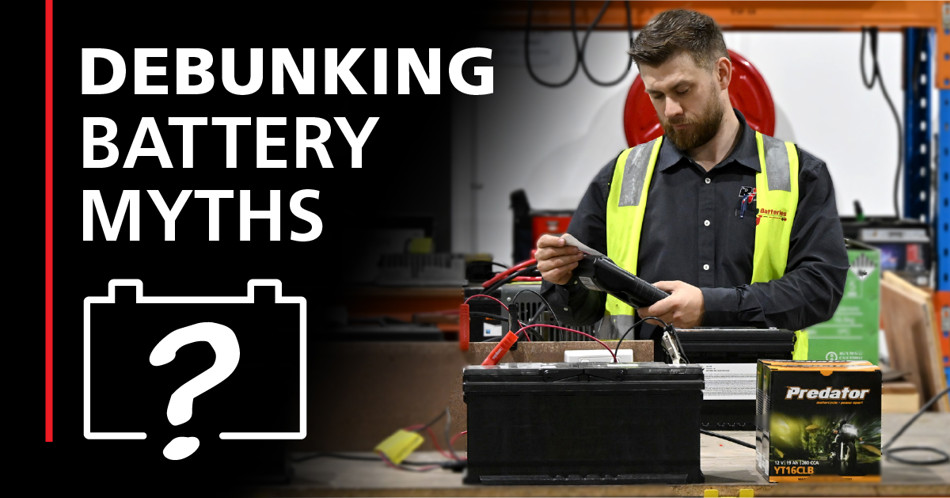Debunking 10 Common Battery Myths
There is a lot of battery misinformation and urban myths circulated by word of mouth and on the Internet. Let’s face it – batteries can be a complex subject to understand, so it can be difficult for ordinary people to distinguish a myth from a fact. In our 29 years of operation, we have heard it all, from innocent misinformation to downright ridiculous misconceptions that can be quite detrimental to the user. Today, our battery experts will be debunking some of the most common battery myths out there to empower you to make informed decisions.

1. Myth: Lithium batteries are not safe and are prone to catching on fire
Fact: While there have been recent incidents of lithium batteries catching fire, it is important to note that not all lithium batteries are created equal. There are several lithium battery chemistries on the market; some are inherently safer than others.
Lithium Iron Phosphate (LiFePO4) batteries like our ALLiON and Predator Lithium batteries are one of the safest lithium battery chemistries. They are not susceptible to overheating or thermal runway and offer superior stability and reliability. To learn more about Lithium batteries and what makes some chemistries safer than others, take a few minutes and read this article.
2. Myth: Maintenance Free batteries never require maintenance
Fact: Maintenance Free batteries, also known as Calcium batteries, got their name from their ability to not require maintenance over a lifetime of normal use. Older lead acid batteries had removable caps on the lid, which allowed the water lost during operation to be topped up periodically.
The introduction of Calcium batteries eliminated the water loss during normal operation, which removed the need for caps and topping up (maintenance). Some larger Calcium batteries still have caps in the lid as they are used in commercial and standby applications where some water can still be lost from the cells. Batteries in these applications require regular checking and topping up as required.
Minor maintenance is still important on calcium batteries to help them last longer. This includes occasionally checking battery terminals for corrosion, which can reduce the current and battery performance.
3. Myth: The higher the CCA, the better the battery
Fact: Cold Cranking Amps (CCA) is a measure of a battery’s ability to flow a large amount of current for a short period of time. CCA is measured with the battery at -18oC, and tells how many amps the battery can deliver for 30 seconds while maintaining a voltage of at least 7.2 volts. There are some battery brands which place an emphasis on their high CCA ratings to convince you that they are better than their opposition. It is however important to keep in mind that in a country like Australia, there are not many places where we experience extreme cold weather. The CCA rating of a battery is directly linked to the number of plates in the battery. To achieve higher CCA numbers, it may be necessary to make each plate thinner to enable them to fit into each cell. Thinner plates generally do not last as long because they are less dimensionally stable and are more susceptible to curling or distortion, which can lead to an internal short circuit, shortening the life of a battery.
So the short answer is a higher CCA rating does not always equate to a better battery. If you are offered a battery with a CCA rating which is significantly higher than its competitors (for the same case size), and it seems too good to be true…….it probably is too good to be true!
4. Myth: You can install a standard Calcium battery in a Stop Start vehicle
Fact: Vehicles with Stop Start systems require specific Stop Start batteries. Stop Start vehicles are designed to switch off the engine when the vehicle is stopped and start the engine again when the brake is released. Stop Start batteries are designed to handle constant cycling and frequent high bursts of power. When the engine is switched off, the battery will continue to power electrical components of the vehicle including the headlights, radio, fan, wipers and other devices.
Conventional Calcium batteries cannot meet the higher power and cycling demands of Stop Start technology. Installing a Calcium battery in a Stop Start vehicle will result in the Stop Start functionality being disabled, and a significantly shorter battery life. We recommend fitting your Stop Start vehicle with our Delkor AGM and EFB batteries which are designed specifically to work with this fuel saving technology.
5. Myth: You can use a car battery to run a boat
Fact: Although you can technically use a car battery to power a boat, marine batteries are constructed differently to make them more suited to the harsh conditions experienced in a boat. Marine batteries are designed to withstand the rough and pounding conditions experienced as a boat powers thought the waves – even on a relatively calm day the vibration is significantly higher than a car. Marine batteries are also often expected to power electrical devices like fish finders or radios, which causes them to discharge. When the engine is started, the battery will charge up again – this is a different situation to what a car battery is designed to cope with. Using a car battery in a boat will work for a while, but will result in a shorter battery life compared to a marine battery. Any cost saved in the purchase of the wrong battery will be diminished against the cost of a tow back to shore with a failed battery.

6. Myth: Driving your car around the block will recharge a flat battery
Fact: Car batteries like to be charged, which is why using your car regularly keeps your battery charged and healthy. When unused for an extended period, a battery’s State of Charge will reduce, and depending on the age and condition of the battery may even run completely flat. Contrary to popular belief, you cannot fully recharge a car battery by allowing it to idle for 10 minutes, or even taking your vehicle for a drive around the block.
Charging systems in modern vehicles are designed to only charge when they have to so they can minimise their effect on fuel consumption. The best solution is to use a battery charger like our OzCharge , Projecta or Hardcore chargers to keep your battery charged and healthy at all times. They are also the most reliable solution for re-charging a flat battery. Alternatively, call your local R&J Batteries branch or distributor to ask for support in recharging your battery.
7. Myth: You can use tap water to top up the water level in a battery
Fact: If your battery is accessible and has caps this is relevant for you. If the battery is low on electrolyte and requires topping up, it is imperative to use only distilled, deionised or demineralised water. The minerals and chemicals in tap water will introduce elements into the battery cell which will contaminate the chemical reaction and damage the battery. It’s handy to have some distilled water in the boot or in your home garage for emergency situations where you need to quickly top up the battery electrolyte. Alternatively, consider fitting your vehicle with a Maintenance Free battery.
8. Myth: You should fully drain your battery of power before charging
Fact: It is a common misconception that you should let your battery to fully discharge before charging it to maximise its functionality. The fact is that doing this will actually cause damage and reduce the battery’s overall lifespan and capacity. The recommended maximum depth of discharge for lead acid batteries is 50%. Lithium batteries with a well designed BMS can be discharged to 100%.
9. Myth: A car battery can run a fridge in a caravan
Fact: A car battery is designed to deliver large current over a short period of time, which is why they are sometimes referred to as starting batteries. It is simply not suitable to run a fridge in a caravan. The correct battery for this application is a deep cycle battery which is designed to discharge and charge; commonly referred to as cycling.
10. Myth: Leaving a battery on a concrete floor can discharge it
Fact: 100 years ago this rule-of-thumb was quite relevant. The case around the battery was made of wood, and the electrical cells were glass jars. If the concrete floor underneath was wet, the wooden case would swell and cause the glass cells to break. Then came porous rubber cases which contained carbon atoms; this also created electrical activity between the cells if the concrete was damp, leading to prematurely discharged batteries.
Modern lead acid batteries are housed in a plastic case which eliminates the issues of 100 years ago. All lead acid batteries will self discharge over time however this is due to their internal resistance, not the material they are placed upon.
There are many other misconceptions around batteries that we simply can’t cover in one article. Batteries can be a significant investment, and we want to ensure yours perform reliably and efficiently for as long as possible. If in doubt, it is always good to check with your local R&J Batteries battery experts before taking any action. Our staff are trained to deal with batteries day so you can trust the experts to give you the correct advice.



